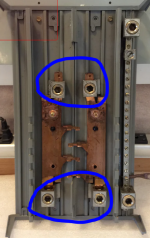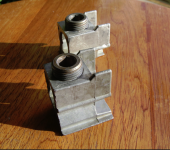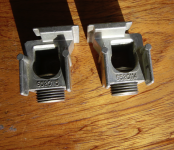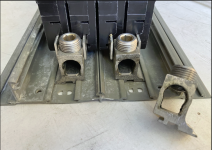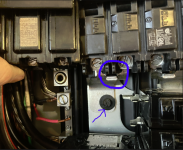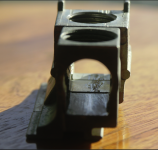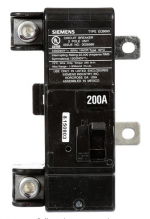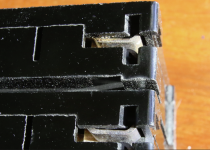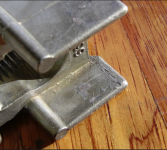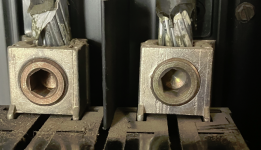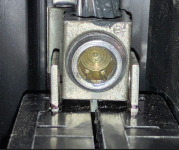MD Automation
Senior Member
- Location
- Maryland
- Occupation
- Engineer
Looking for some possible help from members here for locating older lugs for the line side of a 200A Gould main breaker. Thinking maybe some here have either run into this problem before or have these parts in a pile of spare panels. Or preferably, know where to find either NOS Gould/ITE parts or a similar Siemens lug(s).
First and foremost, I hope this does not get looked at as a DIY post. I am not looking to replace this Main Breaker myself. I know a good electrician from work, who does mostly commercial work, but is willing to help with this residential problem - and I am trying simply to make the job as easy as possible by having all the parts he'd need ahead of time (and hopefully new). He would do the work, meaning pull the meter and swap new parts in. I am looking to do none of it myself, just helping him with parts because he's trying to do me a favor. He does not have a Siemens rep to contact.
The Main breaker in my home's panel is starting to heat up and show too much FOP at the top 2 lugs. Typical 200A service, AL 4/0 SE, meter outside and Main Panel inside directly behind it on the basement wall. Probably been going on for a while, but I first noticed the problem this past weekend when the temps were right around freezing and it was raining here in Maryland. This meant the the heat pumps (I have 2) would tend to go into defrost a lot and, in turn, kick in the electric heat. So at times the service would see loads that could be 70 or 80A easy for a few minutes. When that was happening, I saw temps on the top Line Side lugs of ~170F, hotter than I thought they should be. While I was initially troubleshooting this I saw a ~0.7 volt drop from the line to load side of both legs of the main breaker (when the draw was ~70A??). Running normal, with no big loads (like around 20 amps) the lugs cool right down to ~70F ambient. Measuring with a small handheld IR thermometer.
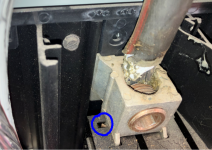
Normally, you would assume it's the connection under the setscrew loosening up around the 4/0 AL wires. But when things are heating up with medium sized loads (like 40+ amps), I measure no meaningful FOP (Fall Of Potential) between the AL strands and the lug itself. But I can probe the top of the slots on the breakers (typical quad 200A) that the stabs on the lug fit around. Earlier today, with a decent load of maybe 40 amps, I measured a voltage drop of around 0.5V between the breaker "slot" (circled in blue above) and the lug itself. So there is some heating going on at those 4 stabs between the Main Lug and the top slots in the breaker. Bigger loads mean more voltage drop and more heat buildup. The lug looks to be a cast part and the stabs (or what I can see of them) don't have that smooth finish like the normal bus stabs you see for the branch circuit breakers. So maybe just an old part starting to slowly corrode and heat up. You can see some of the discolored heating effects around the wire strands and setscrew from the lug getting hot.
The panel is an old Gould G2040MB1200 and the existing breaker is an EQ9483 (obviously no longer made, Siemens bought this line years ago). It's super easy to find a new Siemens 200A Main that is identical (MBK200), but it does not come with the lugs that would fit my old panel. It does come with some bus stabs shown below, but the ones I am looking for have (besides the obvious setscrew lug for the 4/0 wire) some features on the rear of the lug that fit into slots on the plastic tray on the panel. They slide up and down and help "locate" the wire / lug / stab portion of main breaker against that plastic panel backing.
Here is a pic of a replacement breaker with the new stabs...
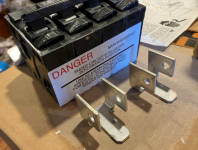
and here are the instructions for this breaker with a new Siemens lug (not included) circled in blue...
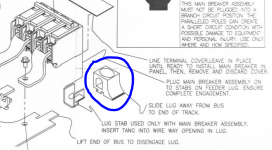
Anyway - just curious if anybody has a good source for NOS Gould / ITE parts like this. Or knows they have decent ones lying around in a pile of parts. Siemens also makes that new lug, you can see it in the MBK200 instructions above (again circled in blue) but it does not come with the breaker and I don't have a part number for it. And it's not quite the same part - it does not have the stabs like the old Gould lug, but I think accepts the tang of the stabs that came with the new breaker. I'm guessing a re-design happened for this part years back? If this new Siemens lug would work, that's great... but again, I can't seem to find a part number for it. I've reached out to my local Rexell supply house, but thought also to ping people on this forum that might know what I am looking for.
Sorry for all the words! Thanks in advance for any help. Just trying to save a panel that is in otherwise really good shape. And again, not looking to do this myself, just trying to source new parts for a proper electrician
First and foremost, I hope this does not get looked at as a DIY post. I am not looking to replace this Main Breaker myself. I know a good electrician from work, who does mostly commercial work, but is willing to help with this residential problem - and I am trying simply to make the job as easy as possible by having all the parts he'd need ahead of time (and hopefully new). He would do the work, meaning pull the meter and swap new parts in. I am looking to do none of it myself, just helping him with parts because he's trying to do me a favor. He does not have a Siemens rep to contact.
The Main breaker in my home's panel is starting to heat up and show too much FOP at the top 2 lugs. Typical 200A service, AL 4/0 SE, meter outside and Main Panel inside directly behind it on the basement wall. Probably been going on for a while, but I first noticed the problem this past weekend when the temps were right around freezing and it was raining here in Maryland. This meant the the heat pumps (I have 2) would tend to go into defrost a lot and, in turn, kick in the electric heat. So at times the service would see loads that could be 70 or 80A easy for a few minutes. When that was happening, I saw temps on the top Line Side lugs of ~170F, hotter than I thought they should be. While I was initially troubleshooting this I saw a ~0.7 volt drop from the line to load side of both legs of the main breaker (when the draw was ~70A??). Running normal, with no big loads (like around 20 amps) the lugs cool right down to ~70F ambient. Measuring with a small handheld IR thermometer.

Normally, you would assume it's the connection under the setscrew loosening up around the 4/0 AL wires. But when things are heating up with medium sized loads (like 40+ amps), I measure no meaningful FOP (Fall Of Potential) between the AL strands and the lug itself. But I can probe the top of the slots on the breakers (typical quad 200A) that the stabs on the lug fit around. Earlier today, with a decent load of maybe 40 amps, I measured a voltage drop of around 0.5V between the breaker "slot" (circled in blue above) and the lug itself. So there is some heating going on at those 4 stabs between the Main Lug and the top slots in the breaker. Bigger loads mean more voltage drop and more heat buildup. The lug looks to be a cast part and the stabs (or what I can see of them) don't have that smooth finish like the normal bus stabs you see for the branch circuit breakers. So maybe just an old part starting to slowly corrode and heat up. You can see some of the discolored heating effects around the wire strands and setscrew from the lug getting hot.
The panel is an old Gould G2040MB1200 and the existing breaker is an EQ9483 (obviously no longer made, Siemens bought this line years ago). It's super easy to find a new Siemens 200A Main that is identical (MBK200), but it does not come with the lugs that would fit my old panel. It does come with some bus stabs shown below, but the ones I am looking for have (besides the obvious setscrew lug for the 4/0 wire) some features on the rear of the lug that fit into slots on the plastic tray on the panel. They slide up and down and help "locate" the wire / lug / stab portion of main breaker against that plastic panel backing.
Here is a pic of a replacement breaker with the new stabs...

and here are the instructions for this breaker with a new Siemens lug (not included) circled in blue...

Anyway - just curious if anybody has a good source for NOS Gould / ITE parts like this. Or knows they have decent ones lying around in a pile of parts. Siemens also makes that new lug, you can see it in the MBK200 instructions above (again circled in blue) but it does not come with the breaker and I don't have a part number for it. And it's not quite the same part - it does not have the stabs like the old Gould lug, but I think accepts the tang of the stabs that came with the new breaker. I'm guessing a re-design happened for this part years back? If this new Siemens lug would work, that's great... but again, I can't seem to find a part number for it. I've reached out to my local Rexell supply house, but thought also to ping people on this forum that might know what I am looking for.
Sorry for all the words! Thanks in advance for any help. Just trying to save a panel that is in otherwise really good shape. And again, not looking to do this myself, just trying to source new parts for a proper electrician



